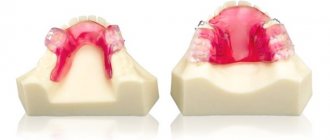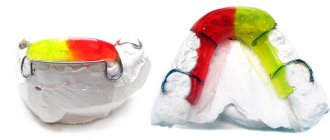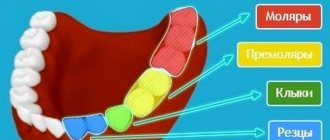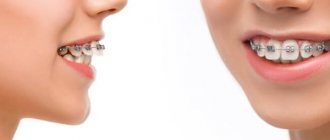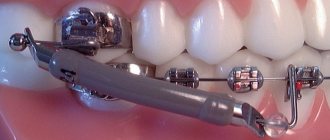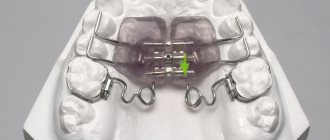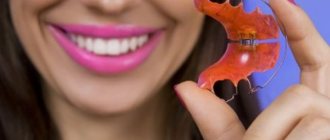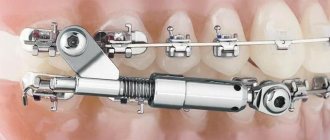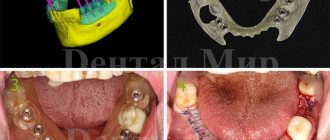4506
Most often, visits to the orthodontist are associated with malocclusion and crooked teeth. This anomaly occurs due to lack of space on the jaw joint during the growth of the front teeth.
Their location is highly compacted, as a result of which they are subject to axial rotation. To expand the jaw space and provide free space for new developing dental units, experts recommend the use of special devices.
Currently, the maxillary fixed apparatus Pendulum has gained popularity, which we will consider in detail in this article.
What is
When a child reaches school age, his bite begins to be mixed and then permanently formed. During this period, various pathologies of occlusion are possible, which can be easily eliminated using orthodontic appliances.
With their help, you can correct the shape of the jaw, accelerate the growth of certain parts of it, or, conversely, reduce the intensity of their development. In addition, such structures effectively change the position of crooked and incorrectly formed teeth.
The Pendulum device is made in the form of a plastic jaw plate. The product is formed according to an individual impression at a multifunctional dental enterprise for the production of dental and maxillofacial prostheses.
The plate is fixed on the teeth using special wire hooks and is easily removed from the oral cavity during meals and hygienic cleansing.
To straighten crooked bone organs, the removable structure is equipped with special elements, the work of which is aimed at exerting pressure on the dental unit. In this case, the generated force will have a given direction.
The patient quickly gets used to the effects of such structures and stops noticing the device after a few weeks of wearing it. Everything is explained by the ease of oral care and the presence of low pressure.
As a rule, the Pendulum apparatus is used in orthodontics to correct abnormal bites in children.
Indications
Orthodontists use the Pendulum apparatus for mechanical correction of the dentition in the upper jaw in adolescence.
Indications for use include:
- correction of lateral dental units back;
- lack of space in certain areas of the dentition (crowding);
- expansion of the upper jaw structure;
- sagittal shape of the position of the upper dentition;
- correction of abnormal bite in children and adults;
- treatment of pathologies or complex use while wearing braces.
Design features of the Quadhelix device and its structure.
In this publication you will learn what Dilyar's face mask is.
Follow the link https://orto-info.ru/sistemyi-vyiravnivaniya-zubov/individualno-izgotovlennyie-apparatyi/tvin-blok.html if you are interested in reviews about the Twin Block device.
Contraindications
In order to carry out a quality correction, you will need not only a competently trained orthodontist, but also a serious patient with excellent hygienic condition of the oral cavity.
Here it is important to constantly monitor carious processes and be prepared for a long period of treatment.
Contraindications to the use of orthodontic appliances include:
- frivolity of the patient's intentions;
- the presence of complex dental diseases in the oral cavity;
- multiple destruction of dental units;
- low qualification of the orthodontist;
- some forms of occlusion pathologies that cannot be corrected using this type of orthodontic appliances.
Design features
The Pendulum device is presented to patients in different modifications, which is determined by the individual characteristics of a particular case.
The product is a non-removable metal structure that exerts a force on the teeth and consists of the following elements:
- the supporting part is a plastic plate that is in close contact with the front part of the palate;
- arch - puts pressure on the teeth;
- rings - used for fixation on molars and premolars of the upper jaw;
- hooks - fixation details;
- screws - serve to adjust the degree of expansion;
- springs are active elements.
In general, the plate is made in the form of a standard design with special clasps that are fixed to the teeth. The arc is passed through the fasteners and is tightened from time to time, exerting a certain pressure on the teeth.
The plate is formed from a soft plastic material, exactly repeating the shape and surface relief of the patient's palate. It is this that serves as a support for holding the metal arc for alignment.
The wire is made from titanium and nickel alloys , which have the effect of returning to the original shape. That is why, under any load, the metal arc will return to the specified shape.
Distalization of maxillary molars in the treatment of class II malocclusion in growing patients
It is no secret that orthodontic treatment, aimed only at correcting the position of teeth and creating correct occlusion, can lead to an undesirable change in the aesthetics of the patients’ faces. Therefore, the goal of orthodontic treatment is not only to create correct occlusion, but also to improve the profile of the soft tissues of the patient’s face and normalize the function of the dental system.
Quite often, removal of permanent teeth for orthodontic reasons is carried out in order to achieve a stable treatment result and depends on the patient’s age, lack of space in the dentition, size of teeth, size of the sagittal gap, etc. In this regard, in the orthodontic literature, much attention is paid to the effect of removal teeth on the soft tissues of the face and bone structures in growing patients.
One of the undesirable consequences of tooth extraction in patients with distal occlusion (Class II according to Engle) is a flattening of the facial profile, prolongation of the period of active treatment and retention of the achieved result with frequent relapses due to its non-compliance. With the development of orthodontic technology in recent years, it has become possible to provide orthodontic treatment to growing patients with class II anomalies without tooth extraction.
Removal of permanent teeth for orthodontic indications (most often premolars and third molars) [1] is carried out after a thorough examination of the patient, including his examination, X-ray examination (orthopantomogram, teleroentgenogram of the head in frontal and lateral projection, cone-beam computed tomography) and measurement of diagnostic models jaws.
One of the reasons for the lack of space in the dentition is the early removal of temporary teeth for therapeutic, surgical or other indications without timely children's dental prosthetics, which leads to mesial migration of the lateral group of teeth. As a consequence, the erupting permanent teeth, most often the upper canines, do not have enough space in the dental arch, and they occupy a vestibular position. This negatively affects not only the profile of the face, the position of the lips, the aesthetics of the smile, but also leads to the creation of an incorrect type of chewing with the absence of the canine path of jaw guidance, functional disorders, and gnathological problems.
When treating such patients, the question is raised of removing permanent teeth to create space in the dentition and moving the canines to the created space. If, based on the studies carried out: measurements of diagnostic jaw models and x-ray examination, a conclusion is made about mesial migration of permanent teeth on one or both sides, then it is possible to use modern fixed orthodontic devices for distalization of molars. These devices are most effective in the final period of the mixed and developing permanent dentition in growing patients, when the second permanent molars have not yet erupted. However, in the absence of third molar rudiments in the upper jaw [2], their use is possible even after 18 years.
Devices for distalization of maxillary molars include both removable extra- and intraoral ones, such as a facebow, plates with a screw and a sectoral cut, which require good cooperation between the doctor and the patient, and non-removable ones, including the Pendulum (Fig. 1), First devices Class (Fig. 2), FROG (Fig. 3) [3, 4].
Fig.1. Pendulum device. Rice. 2. First Class device.
We chose the FROG (Forestadent) and First Class (Leone) devices to clarify the indications for use and study their advantages and disadvantages in the distalization of molars. The FROG appliance was used in adolescents aged 9–11 years in the mixed dentition to distalize the maxillary molars and create space for the maxillary canines.
This device has a compact design and is activated by turning the key counterclockwise. Its feature is the simultaneous movement of the upper molars on both sides. The device consists of supporting crowns for the first molars, paired brackets for the fissures of the first and second premolars (or temporary molars), a palatal plastic button where the screw for distalization of the teeth is located, and a spring that goes from the screw to the first molars (Fig. 3, 4 ).
Rice. 3. Profile of patient S. (10 years old, Engle class II, narrowing of the dental arches, mesial migration of the upper molars, macrodentia. Treatment was carried out using the FROG device for 12 months) before and during treatment. Rice. 4 . Profile of patient S. (10 years old, Engle class II, narrowing of the dental arches, mesial migration of the upper molars, macrodentia. Treatment was carried out using the FROG device for 12 months) before and during treatment.
The crowns of the device were fixed using Fuji-1 chemically cured glass ionomer cement, and the brackets were fixed using Revolution light-curing fluid composite. After installation of the structure, recommendations were given on hygiene and adaptation, which took 1-2 weeks. The device was activated for 6 months, after which it remained in the oral cavity for another six months for retention. A special feature of the device is its easy removal, after which removable plates were used to distalize premolars and canines that erupted during treatment into the created space or bracket system (Fig. 5-14).
Rice. 5. Patient S. State of occlusion in the oral cavity. Rice. 6. FROG appliance on the model and in the oral cavity of patient S. Fig. 7. FROG appliance on the model and in the oral cavity of patient S. Fig. 8. Patient S. at the stage of treatment with a brace system. Rice. 9. Patient S. at the stage of treatment with a brace system. Rice. 10. Face and profile of patient R. (11 years old, Angle class II, narrowing of the dental arches, mesial migration of the upper molars, macrodentia). Rice. 11. Face and profile of patient R. (11 years old, Angle class II, narrowing of the dental arches, mesial migration of the upper molars, macrodentia). Rice. 12. State of occlusion in the oral cavity of patient R. Fig. 13. FROG appliance in the oral cavity of patient R. before and during treatment (treatment was carried out using the FROG appliance for 11 months). Rice. 14. FROG appliance in the oral cavity of patient R. before and during treatment (treatment was carried out using the FROG appliance for 11 months).
The advantage of the FROG device is the constant impact of force on the corpusally moved molars due to the support of the plastic button on the roof of the palate. Support on the arch of the palate minimizes the transfer of load to the frontal group of teeth. Therefore, if the palate is flat, then the load will be transferred to the upper incisors, and the sagittal gap will increase.
Since this device is non-removable, cooperation with the patient is not required, which is important in the treatment of adolescents. Distalization of molars occurs simultaneously on both sides. However, errors at the technical stage can lead to breakage of the structure, rotation of the moved molars, or unwanted pressure on the frontal group of teeth, which will increase their protrusion. The use of the device is advisable in the final period of mixed dentition, when there are still temporary second molars in the oral cavity.
The First Class appliance consists of support rings for the first molars and second premolars, a palatal button to which Ni-Ti springs are attached, and on the vestibular side there are activated screws. Turning the screw one turn per day provides a 0.1 mm expansion of the space between the teeth, which is necessary for distalization of the molars (Fig. 2). The device was also activated for 6 months, after which it remained in the oral cavity for another six months for retention. The use of the apparatus is advisable in permanent dentition, when permanent first and second premolars are already present in the dentition (Fig. 15-18).
Rice. 15. Model of patient M., 11 years old, before treatment; Angle class II, narrowing of the dental arches, mesial migration of the upper molars, macrodentia. Rice. 16. Model of patient M. after treatment with the First Class device. Rice. 17. First Class device in the oral cavity of patient M. (treatment was carried out for 12 months). Rice. 18. Patient M. at the stage of treatment with a brace system.
The appliance was used in adolescents aged 11-12 years in the permanent dentition to distalize the maxillary molars and create space for the erupting canines. In addition to the listed advantages of the FROG device, this design has a more reliable fixation due to 4 orthodontic crowns, therefore, protrusion of the incisors was not observed during body movement of the molars. The screws can be activated on each side in its own mode. However, removing the device had difficulties associated with cutting the crowns.
Thus, distalization of the maxillary molars is the first stage in the treatment of patients with class II anomalies and vestibular position of the canines during mesial migration of the lateral group of teeth. Depending on the clinical case and, accordingly, the choice of device, it is possible to move molars on one or both sides.
The use of the above-described devices for distalization of the lateral group of teeth leads to their corpus movement. This makes it possible to avoid the removal of permanent teeth when treating distal occlusion of the dentition in growing patients, which leads to stable treatment results and has a positive effect on the patient’s facial features and their profile, since it does not cause protraction of the maxillary incisors due to support on the vault of the palate. Many disadvantages of removable devices are minimized: cooperation with the patient is not required, the period of adaptation is accelerated, the period of active treatment is reduced, the number of breakdowns and losses is reduced. And most importantly, these devices help shorten the period of active treatment with braces.
A complete list of references is in the editorial office.
How it works
The plastic plate of the device rests on the sky. The loops of the product are fixed on the distant dental units of the chewing area. Using special hook-shaped fasteners, installation is carried out on permanent teeth located near the frontal zone.
The force generated by the arc is transferred to the teeth and gradually moves them in the desired direction . As a rule, the lateral bone organs move backward. This creates a free space, which allows you to correct the correct position of the front teeth of the upper jaw.
While wearing this orthodontic design, a greatly expanded interdental space may appear. This happens due to the appearance of excess space on the jaw.
However, the patient should not perceive such manifestations as a side effect of using the device. Subsequently, the deficiency can be eliminated with the help of braces, which can correct all defects in the dentition.
Specifics of device operation
The principle of correcting malocclusions is based on mechanical action on a specific area. In this case, the impact must be constant and have a certain force load. Leveling arcs and screws in the plates help achieve this. The orthodontist directly gives them the right direction. Due to constant pressure, the structure of the jaws begins to gradually change: the teeth move in the right direction and twist into their normal state.
The duration of treatment is determined individually. Typically, therapy lasts about 6-12 months. During this period, the arc tension is periodically adjusted and the screw mechanism is corrected. These manipulations allow you to achieve the most precise impact on the required area.
Kinds
During the period of mixed occlusion, any correction is aimed at using the hardware method. In rare cases, specialists resort to complex methods. The bite takes the correct position and shape due to the movement of bone organs and the correction of dental arches.
Functionally, the guide apparatus works not only due to the pressure of the arc on the teeth, but also due to the force of the masticatory muscles, which is transmitted to the dental units through special elements.
That is why Pendulum devices were created in several types, the action of which is aimed at solving certain problems.
With special spring and adjusting screw
The design is based on TMA wire springs, which are designed specifically for this type of structure. In conjunction with them, the work is performed by special Hyrex screws that regulate the degree of expansion.
The device is designed to simultaneously move the lateral group of molars back and expand the upper jaw system.
The use of a built-in spring and screws made using innovative technologies allows you to create a low force to achieve maximum physiological changes.
Nitinol springs can expand the palatal suture without discomfort in a short period of time. Thanks to this, the effectiveness of the correction is noticeable after a few weeks of treatment .
Manufacturing technique of the Ainsworth apparatus and its principle of operation.
Read here what the Nance device is designed for.
At this address https://orto-info.ru/sistemyi-vyiravnivaniya-zubov/kappyi-elayneryi/byinina.html you will learn about the stages of making Bynin’s mouth guard.
Without spring
This type of Pendulum device is equipped with two sectional screws and four special rings for the bandage.
The design has an enhanced impact and displaces dental units on both sides, exerting different pressure.
Others
Among other types of Pendulum devices, the following devices stand out:
- Classic model , equipped with special spring elements without a sectional screw. Fastening is carried out using rings located on the occlusal legs of the clasp.
- Pendex device . Has a special screw for Hilgers adjustment.
- Pendulum with a screw that adjusts the Kinzinger displacement.
- Bi-pendulum . Displaces the first molars on one side.
How does distalization occur if the doctor does not remove anything?
Currently, there are several methods:
- orthodontic miniscrews, to which we can apply a certain force of traction,
- through the use of opening springs,
- due to the separation of certain groups of teeth.
| The orthodontist places a miniscrew. It hurts? And how long can you walk with it? |
Bite correction by our experienced orthodontists-gnathologists means:
- Correction of bites of any complexity and at any age
- noticeable treatment results after 2.5 months.
- more than 324 positive clinical cases
- high-quality diagnostics using more than 50 parameters
- treatment that 100% does not require retreatment in the future
- high-quality effective treatment at prices in the residential area of Yasenevo
Advantages
Before using the Pendulum device, with the goal of expanding the dentition, extraction of dental units from the alveoli is not required .
After the plate moves the chewing teeth in the posterior direction, brackets are applied in the frontal zone, which will give the dentition a straight line and correct the bite.
The main advantages of the device include:
- possibility of three-dimensional fixation of dental units;
- convenient location of the structure, which makes it invisible (the plate is installed under the sky);
- easy device activation;
- Possibility of use in combination with other structures;
- high efficiency indicators and excellent final results;
- the ability to regulate pressure by pulling;
Advantages and disadvantages
The device has a number of advantages.
- Does not violate facial aesthetics. The rings are put on the lateral molars, the plate rests on the upper palate. The device is invisible to others.
- Easy to use. The possibility of force is retained by tightening the screw.
- Compatible with other orthodontic systems. The maximum effect is achieved in a short time, several problems are solved simultaneously.
- The space for the front teeth is effectively freed up in patients with already formed bone tissue. This allows the device to be worn by people of different age categories.
- It is made individually for each patient, taking into account the characteristics of the oral cavity.
- No tooth extraction is required to increase jaw space.
- Possibility of three-dimensional fixation of teeth.
- High efficiency indicators. Correction of pathology in a short period of time. The period of use of the device is on average 6-9 months, depending on the complexity of the clinical case.
- Short production time (10-12 days).
- Hypoallergenic materials are used in the manufacture of the device.
The disadvantages of the system are as follows.
- Discomfort. Feeling of a foreign body in the mouth. The adaptation period takes 2-3 weeks.
- Impaired diction.
- Wearing the structure requires particularly careful oral hygiene.
- The risk of enamel damage increases (in places where metal rings are attached to the lateral molars), and gum injuries are possible.
- Excessive salivation and rubbing of the tongue. In this case, it is necessary to consult an orthodontist.
Wearing time and care
The design is worn constantly and removed only for eating and performing hygiene procedures.
After each removal, the device is washed under warm running water and dried with a paper towel. To facilitate the adjustment period, the plate is made of soft materials and has a thin thickness.
In the first days after installation, the patient will feel minor discomfort, since the plate is installed in the place where the tongue is permanently located.
In some cases, there is a violation of diction, the pronunciation of sounds is distorted. However, such effects disappear quickly , and the patient stops paying attention to the presence of the structure in the oral cavity.
As a rule, under the influence of the Pendulum device, teeth move by 3 mm in 30 days. The duration of treatment will depend entirely on the complexity of the anomaly.
After a thorough examination, the orthodontist determines the period of wearing the structure. On average, the device is used from 6 to 10 months.
Advantages and disadvantages
In dentistry, other structures are used that perform the same tasks, but Pendulum devices are distinguished by the fastest correction times. On average, treatment takes about six months, in complex cases – 9 months. The devices have other advantages:
- Invisible in the mouth. The device is completely fixed in the oral cavity and is not visually noticeable.
- Compatible with other treatment methods. They can be used in complex treatment when different problems need to be solved.
Before installing the system, you need to know about its disadvantages. At first after installation there will be discomfort and pain may occur. Since the design must be worn continuously for several months, daily hygiene becomes more difficult. The installation requires the orthodontist to carefully calculate the pressure force, otherwise there is a risk of damaging the teeth.
Prices
The cost of all types of Pendulum devices will depend entirely on the pricing policy of the manufacturer of the structural elements and the prices for the services of orthodontic laboratories. Let's look at the average cost of popular device types:
- Pendulum (one jaw) - 7,000-8,000 rubles;
- Pendex - 16,500-17,500 rubles;
- Bi-pendulum - 10,000-11,000 rubles;
- Pendulum plus - 9,000-9,500 rubles.
The video shows the process of manufacturing and installing the Pendulum device.
